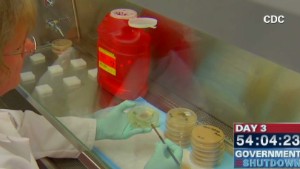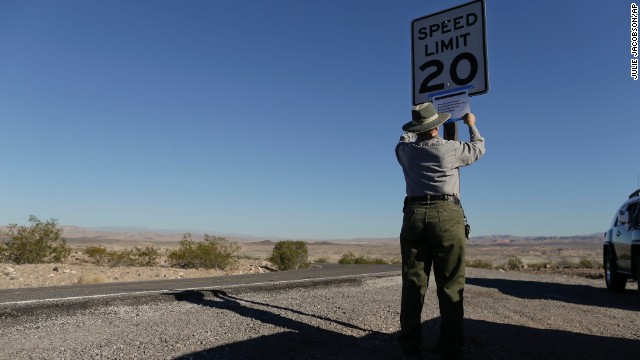STORY HIGHLIGHTS
- Caroline Smith DeWaal: Shutdown can have serious impact on food safety, health
- She says recent salmonella outbreak from chicken shows what effect can be
- She says food contamination can go undetected as food safety offices remain dark
- Writer: Complex cooperation of agencies interrupted. Inspectors need to get back to work
Editor’s note: Caroline Smith DeWaal is food safety director of the Center for Science in the Public Interest, a nonprofit watchdog and consumer advocacy group.
(CNN) — This week, a mother called us about her child hospitalized with a Salmonella poisoning from his day care’s chicken lunch. The child’s condition was tenuous, with a blood infection, and treatment was especially challenging as the bacteria was antibiotic resistant.
The mom turned to the Center for Science in the Public Interest, a nonprofit consumer advocacy group, for information and help because key government’s public health agencies and websites are shut down. Does this have an impact of food safety? You betcha!

Caroline Smith DeWaal
Regardless of whether this illness is related to the outbreak linked to Foster Farms chickens, it illustrates that each case of illness is important to track, and protecting our families from unsafe food should be considered an essential function of government.
When the shutdown began, the Food and Drug Administration announced it would have to halt most of its food safety activities, including routine inspections of food manufacturers and monitoring of imports. The Centers for Disease Control and Prevention shuttered some of its key activities, including outbreak detection and infectious-disease surveillance. The U.S. Department of Agriculture kept its meat, poultry and egg inspectors on the job, but furloughed more than 1,200 other food safety workers.
Despite the agencies’ planning, a government shutdown makes it easier for contaminated food to slip through to consumers and harder for the federal government to identify and respond to outbreaks.
The outbreak linked to Foster Farms chicken—in which hundreds of people were sickened– was already under investigation when the furlough began. Nonetheless, it demonstrate the shutdown’s real human impact, as consumers are left confused about why there has been no recall and whether it is safe to buy the company’s products. Government websites that would normally give them such advice remain dark.
There are other effects of the shutdown that may not be felt for months. During the first six days of the furlough, the CDC shut down its primary systems (PulseNet and OutbreakNet) for gathering information from the state public health agencies. Instead, the few staff left at CDC gathered illness data from the states manually.
 Shutdown fallout may affect food safety
Shutdown fallout may affect food safety
 Parents angry over Head Start shutdown
Parents angry over Head Start shutdown
Although CDC recalled a number of staff from furlough to continue handling the salmonella outbreak, the agency may end up weeks behind in investigating new outbreaks as it gets its systems up and running again. Meanwhile, key personnel at the food safety agencies that are tasked with preventing outbreaks are not at their posts, investigating suspect facilities, checking imports or analyzing lab samples.
Outbreak investigations involve a complex choreography among many state, local and federal agencies. They begin with state and local agencies receiving reports of illnesses, investigating them, and forwarding their findings to CDC. CDC aggregates these state reports with data collected from monitoring programs. Next, it sifts through huge volumes of information to link up illnesses occurring in different states, identifying common pathogens and common food sources. That information is forwarded to USDA and FDA, which try to track outbreaks to their sources.
USDA or FDA may issue a public health alert or issue a recall (or demand that a company recall potentially tainted foods), alerting consumers to avoid certain foods and getting them removed from supermarket shelves.
Consumers only see the final action but have little knowledge of the complexity and labor- intensive steps by multiple agencies needed to take it. Yet 10 days ago, Congress sent these public health officials home and left consumers (and the food industry) vulnerable to the effects of dangerously contaminated foods.
Food borne disease is preventable, yet 48 million consumers suffer illnesses each year. Usually symptoms are just an upset stomach, but more severe symptoms send 128,000 people to the hospital and kill 3,000 annually. Those who recover may still suffer life-changing conditions, such as kidney failure, Guillain-Barré syndrome, and reactive arthritis. Our national investments in food safety are important tools that can help reduce those numbers.
In the best of times, investigations of outbreaks of food borne illnesses are complex and hard to solve. But it is truly reckless to continue this government shutdown and leave so many, like the mother and child who called this week, unprotected.
Follow us @CNNOpinion on Twitter.
Join us at Facebook/CNNOpinion.
The opinions expressed in this commentary are solely those of Caroline Smith DeWaal.
Read More:
The post How shutdown risks health appeared first on Arne Ruhnau News.
via Arne Ruhnau News http://arneruhnau.com/how-shutdown-risks-health/
 A man sorts golden king crab in Auke Bay in Juneau, Alaska, in March 2007. The partial government shutdown has left crab fleets in limbo without any federal employees to set rules and quotas for the fishing season. A delay of even a few days could be costly, a congresswoman from Washington state warned in a House speech last week.
A man sorts golden king crab in Auke Bay in Juneau, Alaska, in March 2007. The partial government shutdown has left crab fleets in limbo without any federal employees to set rules and quotas for the fishing season. A delay of even a few days could be costly, a congresswoman from Washington state warned in a House speech last week.  Georgia and Keith Ormand stop to take a picture near the entrance to Mount Rushmore National Memorial in Keystone, South Dakota, on October 1. Traffic cones were put up for a short time at a pull-off where people could view the monument. Some said it was to deter tourists from stopping.
Georgia and Keith Ormand stop to take a picture near the entrance to Mount Rushmore National Memorial in Keystone, South Dakota, on October 1. Traffic cones were put up for a short time at a pull-off where people could view the monument. Some said it was to deter tourists from stopping.  Austrian tourist Ryszard Skrzypek snaps a photo of his wife, Walendowska Malgorzata, close to the entrance to Grand Canyon National Park near Tusayan, Arizona, on Friday, October 4. Park officials have written citations for people trying to sneak into the park.
Austrian tourist Ryszard Skrzypek snaps a photo of his wife, Walendowska Malgorzata, close to the entrance to Grand Canyon National Park near Tusayan, Arizona, on Friday, October 4. Park officials have written citations for people trying to sneak into the park.  Tourists watch the Old Faithful geyser in the Yellowstone National Park in Wyoming in June 2011. One tourist told a Massachusetts newspaper that National Park Service guards treated members of her tour group brusquely and told them not to “recreate” while taking pictures of bison.
Tourists watch the Old Faithful geyser in the Yellowstone National Park in Wyoming in June 2011. One tourist told a Massachusetts newspaper that National Park Service guards treated members of her tour group brusquely and told them not to “recreate” while taking pictures of bison.  Park maintenance worker Donna Curry tapes up a sign on October 1 notifying visitors the picnic facility in Lake Mead National Recreation Area near Boulder City, Nevada, is closed. A Nevada couple told CNN affiliate
Park maintenance worker Donna Curry tapes up a sign on October 1 notifying visitors the picnic facility in Lake Mead National Recreation Area near Boulder City, Nevada, is closed. A Nevada couple told CNN affiliate 




No comments:
Post a Comment